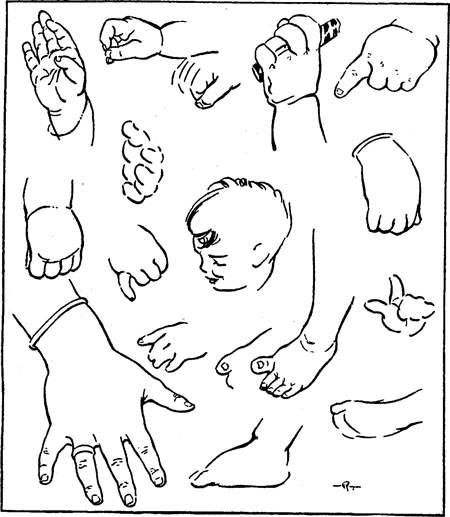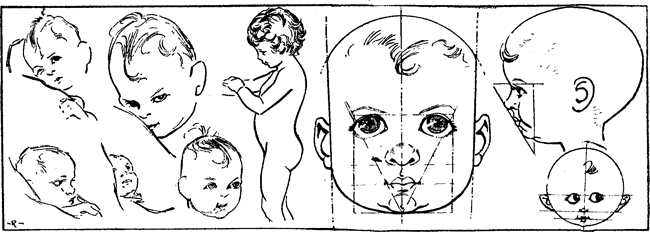Home > Directory of Drawing Lessons >How to Draw People > How to Draw Children > Drawing Kids in Correct Proportions
DRAWING KIDS : Proportions and Measurements of Children, Toddlers, and Babies & How to Draw Them
|
|
The Anatomy of the Child and How to Draw Children
The bones in the child's head at birth are soft and easily moved about, since the joints formed by the bones have not yet firmly united. The skull, from the eyebrows up, is the largest portion of the head. The eyebrows have not grown out as yet, except in rare instances. The upper eyelid is at about the center of the face. The eye is proportionately very large. Often the iris seems to cover the entire visible portion of the optic. Gradually, as the eyelids grow wider apart, the cornea appears to grow smaller. It is this apparently large iris that makes a baby's face seem always to be starey, to be "all eyes." The features can be laid out by the block method shown in the accompanying illustration. This will assure proper proportion, as otherwise you may be inclined to draw the features, particularly the nose and chin, a bit too large. The nose is short and usually pugged, the nostrils are small. The lips are small and dainty. The cheeks are round and pink, with a white highlight in the center. The chin is very small — about the distance proportionate to that between the base of the nose and the center line of the lips. The ears are considerably larger than the other features. When he weeps or yells the baby's face takes on a different contour, his mouth being much distended. The skeleton is the same in every detail in babyhood as in later life, the only difference being in the proportionate development. The head is obviously at variance in proportion in comparison with a full grown man. A baby is normally four heads high. It does not begin to walk until almost a year old, and then it careens across the carpet like a sailor in a "wet" port.
Its body seems stouter than its legs, which are even shorter in proportion to the body proper. The abdomen is usually rotund. The muscles are soft and pudgy, and the flesh, particularly at the wrist and ankles, laps over, showing a marked depression line. The lines in the hands are not well defined. The hand is usually chubby and dimpled at the knuckles. The finger from the palm tapers toward the end. The foot can be shown with a triangle. The nether part of the arch seems not to be formed as yet. The base of the foot is fiat. A baby is difficult to draw when awake, easy when asleep. A very young child awake is a hard subject because of its restlessness fidgety, curious, highly expressive, like a moving picture with each move of the film we see another pose. Children, and particularly babies, are quick to show their thoughts in outward expression. They are natural actors in this respect. You Might Also Enjoy Our Drawing Tutorials for Drawing Kids and Drawing Babies and Drawing the Face and for Drawing Figures in Correct Proportions |
Privacy Policy .... Contact Us






